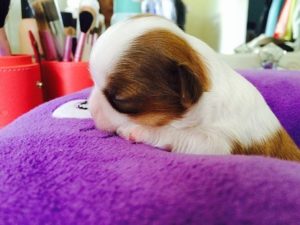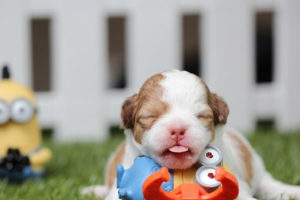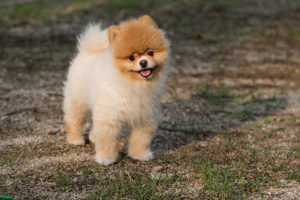Puppy rearing can be rewarding, almost magical, but it does require much work on the part of the person caring for the pups. Whether you are a breeder just starting out, or find yourself in a position to foster the care of a litter of puppies, there are several things you should know to produce puppies that are healthy, happy and well socialized

Puppy Development
From the time your puppy is born (technically whelped) he has everything he needs to survive which is very little – the drive to eat and stay warm. Your baby can do this very quickly without being able to see or hear.
During the first two weeks of life, puppies can root around to find the best location at the milk bar. They make tiny sounds or louder cries if something is not right. They will crawl up on each other into a tight pile to sleep. Most puppies twitch as they sleep which is entirely normal.

This blissful state lasts for approximately two weeks, at which age the puppies begin to open their eyes and then their ears within a few days. With these newly acquired senses, their world begins to change. Puppies become active, some may try to crawl out of the whelping box, and the first few attempts at standing happen at this stage. Mom continues to do most of the care, feeding and then clean up. By the time the puppies reach 3 weeks, their bodies are better at regulating heat, and you will find some puppies choose not to sleep in the puppy pile.
These two weeks, from the time their eyes and ears open, until they can walk and move around is often called the Identification Period. Pat Hastings, in Another Piece of the Puzzle: Puppy Development, identifies the period between 3 and 4 weeks as an Awareness or Identification Period. This period is marked by a good sense of hearing and vision, better coordination, and a beginning awareness of self. Many puppies find their “voice” during this period, and little barks and growls can be heard. Puppies begin to bond to the caregiver and enjoy being held and stroked.

At about four weeks, puppies are ready to eat a soft gruel made from dog food and extra warm water. Most will lap it up especially if additional milk replacer power or goats milk has been added.
By five or six weeks old, puppies resemble little adults. They have learned to walk, run, walk backwards and play with their littermates. Barking, growling and sometimes howling can get overwhelming when puppies play hard with each other. Little teeth erupt and mouthing feels more like biting as the tiny teeth experiment with human skin.
By this time, puppies are in the process of being weaned and can spend more time away from their mother. Mothers also prefer to spend less time with them. Every toy presents a new adventure and challenge. In fact, anything novel in their environment is greeted with curiosity.
By eight weeks of age, many puppies are ready to go to their new homes. Their brains are fulling functioning and are capable of learning most anything. Many behaviorists believe this is the best time to train because learning at this age is permanent and if done in a positive, gentle way, skills are acquired quickly.
What do young puppies need?
If mom is with her puppies, you, the human still has plenty of jobs to keep you busy. What do puppies need?

Puppy rearing tasks can fall into about 10 different categories. The following is a summary of each puppy need and how a human can help the puppy best meet their requirements.
Warmth
For the first 3 weeks, puppies are not able to regulate their body temperature, so an external heat source such as a heating pad or heat lamp will help keep them warm. Mama dog will also lend her own body heat, but if not, a heating pad that has a mechanism to stay on all the time is recommended. Set the temperature to low or medium. The room temperature should also be kept extra warm.
Food
Puppies will nurse from their mother’s milk until weaned. If the mother is not available, a supplemental formula will need to be fed to the puppies about every 2 to 4 hours around the clock. Commercially available formulas are available, and the ones made from goats’ milk are superior to those made from cows’ milk. If you are feeding, you will need to purchase a small dog bottle and nipple kit. Syringes without the needles also work well. Be sure to keep these items very clean and the formula refrigerated.
As the puppies get teeth, you can gradually switch to dry kibble, but provide cool fresh water always.

Vitamins and Supplements
Some breeders routinely give puppy vitamins and other supplements. There is some disagreement as to whether this is required or not. Check with your veterinary for recommendations.
A Clean Environment
The puppies’ immediate environment needs to be kept clean. Mama dog takes care of cleaning for at least the first 3 weeks, and some moms continue to perform this duty longer. Once the puppies are up and about, keeping a clean environment is essential for their health. Pick up feces as soon as possible and use a good animal disinfectant that can remove germs specific to animals. If you want to start pad training the puppies, place several pads in their area away from the food and bedding. If you are lucky, they will pad train themselves!
Worming
Socializing
Puppies need to be socialized and the puppies that receive the most socialization from day one are the ones that will end up becoming the best pets overall. This doesn’t mean that you should take a 2-week-old puppy to the dog park. That can occur much later if at all.
Initially, small puppies need to be handled, touched and placed in different positions. Pick up puppies regular and rub their paws, tails, back, and stomach. Pet their faces and open their little mouths. Hold them in different positions also, such as on their back, on the stomach, and vertically.

As puppies grow, allow others to touch, pet and play with the puppies. Without overwhelming them, the more people they interact with, the better overall. Provide different types of toys and novel objects in their environment to investigate. Feed for different kinds of bowls. Allow the puppies to walk on different types of surfaces such as tile, concrete, carpet and so forth.
Eventually, you will want to introduce the puppies to the outdoors, weather permitting and give them a chance to discover grass. Introduce them to a variety of different household sounds such as the vacuum cleaner, blender, music, the sound of the television and so forth. The more that puppies experience in a safe, comfortable environment, the less chance they will develop fears and anxieties as adolescents and adults.
Safety
Vaccinations
Grooming

Training
Conclusions
Author bio: Janice Jones is an avid Shih Tzu lover who lives, grooms, trains and cares for her pack of Shih Tzu dogs. When she’s not actively playing canine games, she loves to write and enjoys teaching and helping people understand their four-legged friends. https://www.miracleshihtzu.com
![12 Best Dog Foods for Toy Breeds [Buyer's Guide] 12 Best Dog Foods for Toy Breeds [Buyer's Guide]](https://shihtzuexpert.com/wp-content/uploads/2019/05/3-5.jpg)


![Custom shape wireless dog fence [Electric Fencing and Electric Barrier Systems] Custom shape wireless dog fence [Electric Fencing and Electric Barrier Systems]](https://shihtzuexpert.com/wp-content/uploads/2019/07/Custom-Shape-Wireless-Dog-Fence-Review.png)
